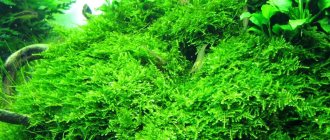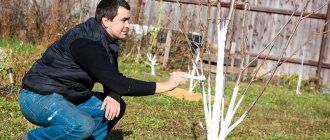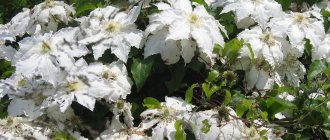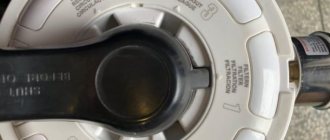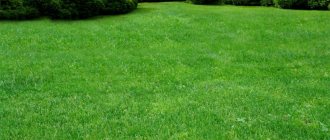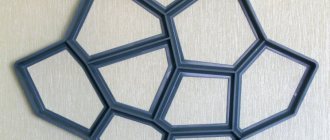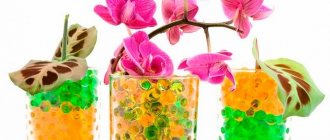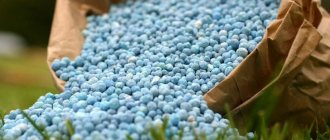Types of hydrogel
First you need to understand what a hydrogel is. This is a substance obtained from polymer components that are capable of absorbing liquid while simultaneously increasing in size.
Positive properties:
- maintains moisture balance;
- retains nutrients in the soil longer, allowing seedlings to better absorb them;
- loosens the soil and structures it;
- accelerates plant development;
- protects the soil from cracking and drying out.
Flaws:
- It is better to place plants growing in pure hydrogel in shaded areas, since under the rays of the sun the water blooms and emits an unpleasant odor;
- colored granules quickly lose color, and in bright light they lose their decorative effect;
- The granules on the surface dry quickly. At the bottom of the container without air they become moldy.
They produce 2 types of this substance, differing in their characteristics and methods of use:
- Hydrogel – a soft, uncolored polymer used as a leavening agent and to moisturize plant roots. This is a material with a jelly-like structure; plant root hairs, penetrating into the granules, absorb nutrients and water;
- Aqua soil - a denser polymer, it is produced in the form of granules of various shapes and colors. Used for decorative purposes and as temporary soil for plants.
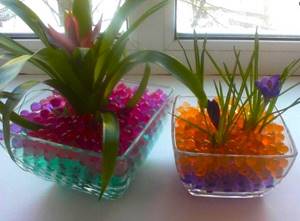
Dry hydrogel can be of 2 varieties:
- Uncolored powder or small granules without a defined shape;
- Small colored (yellow, green, blue, red) granules of regular shape (cubes, balls, etc.).
These types of hydrogel differ only in appearance; the characteristics of colorless and colored granules are identical.
Advantages and disadvantages of hydrogel for gardening
Advantages of hydrogel for the garden:
- Accelerates seed germination, ensures faster growth of seedlings, increases productivity
- Having been saturated with liquid fertilizer, the granules then feed the plants for a long time
- Soil mixed with hydrogel has a looser structure, which improves the breathing of the plant root system
- The survival rate of seedlings in soil with hydrogel is more than 95%
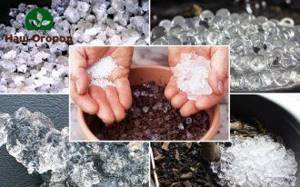
Hydrogel: photo
Disadvantages of hydrogel for the garden:
- Not suitable for germinating seeds with a hard, leathery shell (beans, sweet peas)
- Under prolonged exposure to the sun, mold appears on the hydrogel
- The plant is grown in pure hydrogel for up to 2 years, and then the gel is changed
Where can I buy hydrogel for house plants?
Decorative dense hydrogel can be found in hobby departments and flower shops. Many different types of hydrogel are sold in online stores that are focused on selling eco-soil, where it is called aqua-soil. The cost depends on the manufacturer. If you have not used this substance yet, then purchase a small bag of colorless granules or one color for testing. Multi-colored products will cost more.
Which variety to choose depends on the purpose of the purchase. Simple, inexpensive sets are only suitable for planting plants; if you need to make an original gift or decorate the interior, it is better to purchase a more expensive set.
Application in gardening and horticulture
Granular polymer is not used for all vegetable crops. Often, the use of hydrogel negatively affects the condition of plants: the gardener hopes that the soil is moist from the inside, and does not always water the beds on time. The result is slow growth and wilting of vegetable crops.
In vegetable growing, hydrogel is used for a limited list of types:
- potato;
- radish;
- tomatoes;
- cucumbers;
- cabbage.
The granular composition is buried approximately 5 cm and mixed with soil. For heavy, loamy soils per 1 sq. m, 20–30 g of polymer are added; for light soil, 10 to 20 g of hydrogel is sufficient for the same area.
Application in gardening:
- moistening the soil, creating a looser substrate when planting young trees, propagating shrubs by layering and cuttings. For 1 part of hydrogel take 5 parts of soil. The procedure is useful in areas where the soil quality is not as good as required for certain types of fruit trees and shrubs. For young shrubs and seedlings, a swollen hydrogel is useful so that the roots gradually extract moisture from the polymer granules;
- removal of stagnant melt water after sudden warming amid heavy snowfalls in winter. Dry hydrogel is scattered over the area and mixed with soil;
- moistening the soil near apple trees, cherries, pears, plums and other fruit trees. The older the plant, the more granules are needed to improve the quality of the soil and gently moisten the soil over a long period. Average consumption: 20–40 g of polymer granules per tree. First, punctures are made in the near-trunk zone to a depth of about half a meter; not only the optimal amount of polymer is poured into the holes, but also fertilizing (mineral fertilizers). Next, add the substrate, fill the holes with hydrogel, and water the soil well. As the granules swell, the substrate around the trees often rises slightly. For shrubs, consumption is less: from 3 to 10 g, granule depth: 25–30 cm.
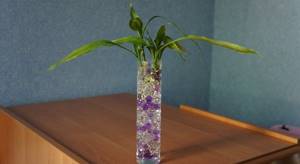
Composition and instructions for use of hydrogel
Ivy, cyperius, scindaptus, syngonium, tradescantia, chlorophytum, codiaeum, hypoestes, scheffelera, cordyline and dracaena plants grow well in the hydrogel. But you should not plant crops in this substance that require a small amount of water (epiphytes, succulents), storing moisture for the future in roots or tubers, with dense leathery leaves.
- Pour 500 ml of water into the contents of the package;
- After 12 hours, the composition will absorb the required amount of liquid and will be ready for use (you can add the necessary fertilizers to the water in advance), each particle will increase to 1.5 cm;
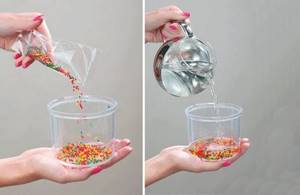
- Wash the soil from the roots of the transplanted plant;
- Place the polymer balls in a container for the plant; if you want to create a multi-colored composition, it is a good idea to use a transparent vase for the seedling;
- After drying, the used hydrogel takes on its original appearance; it can be saved until the next use or refilled with water and planted with a plant or cut flowers.
The substance is economical; 1 small sachet is enough to obtain 500 grams of soil, which is enough for a narrow vase or pot.
If the top part of the gel dries out, then you need to remove the dried granules and soak them in water for 1 hour. By adding hydrogel to the soil mixture, you create a strategic supply of nutrients and moisture for the roots. At the same time, you can reduce the number of waterings, and the feeding compositions will not burn the roots of the plants.
The use of hydrogel in a summer cottage
The hydrogel is added soaked and dry to any crop. Polymer granules will help solve the problem of high groundwater levels in your area; it will remove water from the roots. The component, pre-soaked in a fertilizer solution, will immediately deliver nutrients to the roots of the plants.
Under mature trees, hydrogel is added taking into account the vigor of fruiting and age (within 20-40 g). According to the size of the crown around the trunk, the soil is pierced 50 cm with a sharp object, and the hydrogel is poured into these punctures. It is also added under bushes at a dose of 3-10 grams to a depth of no more than 30 cm.
The hydrogel cannot be shallowly embedded in the soil; if it ends up on the surface of the soil, it will disappear right before your eyes under the rays of the sun!
Application of hydrogel
Initially, the purpose of using hydrogel was to improve the structure of the soil, but over time its functions have expanded significantly.
Hydrogel improves soil structure
To improve the soil structure, hydrogel is placed in the beds before planting. As a rule, it is pre-soaked, because otherwise the gel can draw moisture from the soil and dry it out. But if, after melting snow or heavy rain, the bed is waterlogged and you need to plant plants, add a little hydrogel granules. After some time, the granules will absorb some of the water, and over time they will release it to the plants.
Hydrogel for pot culture
When preparing soil mixtures for growing plants in pots and cache-pots. The application rate of dry granules is one gram per liter of soil. But remember that the granules will increase significantly in volume after watering, so do not fill the containers to the top. An excellent effect is achieved by introducing swollen granules into the soil substrate, which have been filled with a solution of complex mineral fertilizers. In this case, add a glass of jelly-like swollen gel per liter of soil soil.
Transplanting seedlings into the ground
When planting seedlings, the roots of the plants or the soil cube in which the seedlings were grown are immersed in the swollen gel. And then they plant it in the hole. Gel on the roots or earthen cube will provide moisture and nutrition to the plant, thereby helping it take root in a new place.
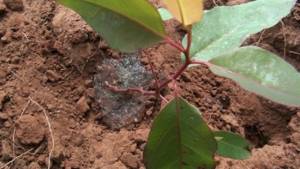
Sowing the lawn
Anyone who has grown a lawn from scratch knows how difficult it is to provide favorable conditions for small seeds at the initial stage. Frequent watering compacts the soil; under the rays of the sun, a crust forms on it, preventing the germination of young shoots. But hydrogel will come to the rescue.
To do this, fill the hydrogel with a solution of complex fertilizer, for example, “Fertile Forte”, according to the instructions. Let swell for 30-40 minutes. Then spread over the surface of the soil prepared for sowing at the rate of 1.5-2 liters per square meter. Embed the hydrogel into the soil to a depth of about 10 cm. Sow grass seeds in the usual way, roll, and water. After germination, the young shoots will be provided not only with moisture, but also with high-quality constant nutrition.
Hydrogel on a vegetable bed
In the same way, by adding hydrogel with a fertilizer solution to the soil of the bed, you can sow vegetable seeds. In this case, the plants will be able to withstand 7-15 days from watering to watering, depending on weather conditions.
Attention! For vegetables with a long tap root system, for example, carrots, parsnips, granules are laid at a depth of 20-25 cm.
It is important to remember that watering when using hydrogel is done 2-4 times less often. But they must be much more abundant so that the moisture reaches the granules and is enough for them to swell.
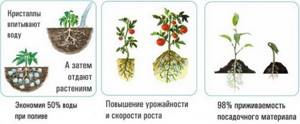
The use of hydrogel will be very useful for those who do not have the opportunity to visit their site every day. Miracle polymers will be a real salvation for gardeners in the southern regions, where hot, dry weather is by no means uncommon. The hydrogel will help provide plants with the most favorable conditions.
If you have not yet read the article “Special fertilizers for tomatoes,” you can read the link.
To stay up to date with all new publications, subscribe to the newsletter by entering your email address!
Growing indoor plants in hydrogel - the latest technologies
The hydrogel will also help plants growing on the windowsill. If you are planting in a new pot, then add pre-soaked polymer to the soil mixture. Moisten it well (1 g per liter of soil) and let it absorb water. You can soak it overnight.
During planting, mix the prepared granules with the soil mixture, then plant the plant according to the general rules. After planting the seedling, water it; the roots have not yet adapted to the new place, but they need nutrients. You can feed only with water-soluble compounds and not as often as plants in regular soil.
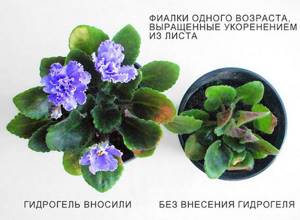
If you need to add polymer to a pot with a growing indoor plant, you must first calculate its volume. For 1 liter you need to add 1 g of dry granules, this is about 1/4 teaspoon. Make holes in the soil to the bottom of the pot and pour the hydrogel into them.
The granules greatly increase in volume, for this reason you must not make a mistake in calculating their quantity.
Then the plant needs to be watered; if some granules appear on the surface, they need to be sprinkled with soil 1-2 cm thick; after a short time, the roots will reach these granules. And lack of moisture for 15-20 days will not harm them, so if you go on vacation, you will not have to worry about your pets.
What is hydrogel for plants and how does it work?
According to the chemical formula, hydrogel refers to polymers (cross-linked copolymers) capable of holding large amounts of water and fertilizer solutions. The absorbency of the hydrogel is such that 1 g of dry matter can absorb 0.2-0.3 liters of water.
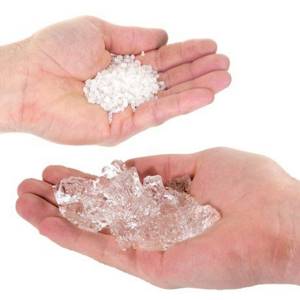
Dry hydrogel and saturated with water - an increase of 200-300 times!
For the hydrogel to start working, it must be added to the soil in the access area of the plant’s root system. Most often - in an already swollen state, saturated with water, less often - in a dry state (then it requires abundant watering immediately after application).
After 2-3 weeks, the plant’s roots will grow through the hydrogel capsules and will be able to absorb moisture from there without waiting for the next watering. The soil may dry out completely between waterings, but this will no longer be a shock to the root system. The hydrogel will be a backup source of water, which will prevent the plant from withering and drying out during dry periods.
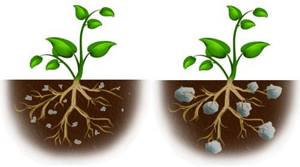
The roots of the plant grow into the hydrogel and begin to be fed with water from there.
Hydrogel granules can be saturated not only with water, but also with fertilizer solutions. Then, in your absence, the flowers will not only not wither, but will also continue to feed “properly.”
Due to its ability to adsorb moisture, the hydrogel has another property: it will not allow the flowers to flood. All excess moisture that would normally drain through the drainage holes is absorbed into the hydrogel and then absorbed by the plant as needed.
I would like to immediately note that this article is not about Chinese hydrogel or, as it is also called, “aquasoil”. These are slightly different materials, although they have a similar polymeric nature. The purpose of agricultural hydrogel is to serve as a source of additional water for plants. The main purpose of aqua soil is a decorative effect.
Seed preparation
After the spring treatment of vegetable or flower seed, you don’t have to dirty your apartment with soil, but use hydrogel for this. You need to pour 4-5 liters of hot water with dissolved nutrients, 2 tablespoons of polymer granules. In this case, you need to be careful: the amount of fertilizer must be reduced by half the usual dose, so as not to damage the delicate roots of the seedlings.
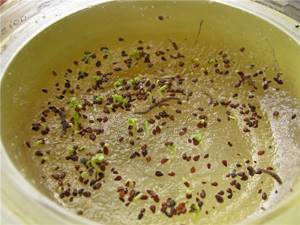
After 2-3 hours have passed, excess moisture must be drained, and the soaked granules should be placed on polyethylene film, dried for an hour, and then placed in seedling boxes. The seeds are placed on hydrogel and slightly moistened. The boxes are transferred to a greenhouse, where the young seedlings will be comfortable.
How to grow indoor bamboo: careful care at home
Read about the use of succinic acid for feeding indoor plants in this article.
Reproduction methods and proper care for dipladeniya at home: https://sazhaem.info/plants/blooming/dipladeniya/uhod-i-razmnozhenie-dipladenii.html
What is hydrogel
The powder or beads are translucent or almost white in color - this is a converted polymer. A specific feature is the ability to absorb moisture in large volumes. Polymer granules, powder or rounded particles absorb about 200 g of water per 1 g.
Important characteristics and properties:
- Once absorbed, the liquid may evaporate or penetrate into the soil. Just a couple of tablespoons of hydrogel accumulates about 3 liters of water.
- After placing polymer particles into the soil, the process of gradual release of liquid into the environment - the soil - begins. This property allows you to nourish flowers with life-giving moisture if the owners do not have the opportunity to water indoor flowers daily.
- The same effect is obtained when adding a granular product to open ground, under trees in the garden and on beds with vegetable crops.
- It is no coincidence that the name of the product contains the base “hydro”, which means water. Hydrogel is a “lifesaver” in all situations when adding moisture to the soil is required, but the owner cannot participate in the process himself.
How to make hydrogel at home
When growing plants in an apartment or in a garden, they use filler for diapers and pampers. This component works in the same way as hydrogel, improving conditions for plants and prolonging the life of cut flowers.
For this you will need nutritious soil and a diaper; first you need to cut it and remove the absorbent granules from it. After which they are poured into a container and filled with water. As a result, a gel-like mass is formed; it is mixed with the soil mixture in a 1:1 ratio; this gel absorbs moisture and releases it for a long time.
The result is a loose and nutritious mixture, which with regular, infrequent watering will always be moist. Crops growing on such soil will receive as much moisture as they need. The roots will not become moldy or begin to rot.
A guide to using hydrogel for growing indoor flowers in this video:
How to use hydrogel for plants.
- General recommendations.
· Hydrogel for agriculture can be used in two ways: mix dry granules with soil in the recommended proportions, plant the plant and water it abundantly; or first prepare the jelly by filling it with water, and then mix the finished gel with the soil.
· To prepare the hydrogel
(to make jelly from it), you need to add 10 grams (a tablespoon) of dry granules to 1 liter of water and give them time to swell for about 30 minutes; then place it in a colander to remove excess moisture and mix with soil in a proportion of approximately 200 ml of jelly per 1 liter of soil. Then use the resulting soil when planting. To germinate seeds, you do not need to mix jelly with soil.
· To apply the substance under mature shrubs and trees, use the method of punctures under the root system. Then dry granules are added to the wells at the rate of 3-5 grams per well. There should be 15-20 holes in total in a circle. Then the plant is watered abundantly.
· When using hydrogel in sandy soils, the recommended consumption should be doubled;
· When planting, you should follow the recommendations for polymer dosage, because when swelling, it can displace the plant from the soil;
· When planting in containers, you should leave free space in the container, because after the gel swells, the volume of the finished soil will increase by 20-30% or mix the finished gel with soil in a 1:1 ratio
· After adding hydrogel to the soil, the frequency of watering should be reduced by at least 2 times
Germinating seeds in hydrogel
The prepared hydrogel (in the form of jelly) is placed in a container for germination with a layer of at least 3 cm. Medium and large seeds are placed on top of the gel and buried a little, but not more than 0.5 cm. Then covered with film and put in a warm, dark place. After the sprouts appear, they are placed in the light and the film is removed. Then they dive as with normal germination.
I recommend placing small seeds not on the hydrogel itself, but on gauze on top of it. This will prevent them from sinking deep into the gel. Or put a thin layer of soil on top of the gel and small seeds on top.
After germination, the seeds are planted in the soil with a small addition of the hydrogel in which they were germinated (about a tablespoon).
When sowing seeds, waterlogging of the hydrogel should be avoided.
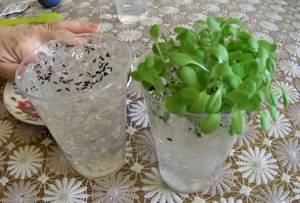
Using hydrogel for seedlings
To grow seedlings, it is recommended to mix the prepared hydrogel with soil in a ratio of approximately 1 to 4 and grow the seedlings in this soil. This will reduce the need for regular watering several times. Seeds can be germinated either in pure jelly or in such prepared soil.
Upon landing
The absorbent is added dry to the hole under each plant in the recommended volume depending on the type of plant. Then water generously.
Another use option is to dip the roots and stems in a concentrated ready-made hydrogel before planting in the ground. To do this, it is recommended to use the finest polymer fraction. The jelly envelops the roots and provides the young plant with an initial supply of moisture for further growth.
Should I use hydrogel: pros and cons
Most flower growers, gardeners and gardeners speak positively about hydrogel:
- The best option when growing ornamental, fruit and vegetable crops is to use a “soft” category product to moisten the soil and activate the supply of nutrients to all parts of the plants.
- The complex effect (hydrogel balls optimize the level of soil moisture: if there is a deficiency, it fills the soil with water, if there is an excess, it absorbs excess liquid) helps to grow a good harvest and luxurious flowers.
- When comparing lists of advantages and disadvantages of hydrogel, it is easy to notice: there are many more advantages. Soft granules made from a safe polymer literally save flowers when the owners leave for a long time, and help gardeners and gardeners replenish the soil in arid regions and in “heavy” soil.
Opinions about aquasoil (solid hydrogel) are not so clear-cut. Synthetic material is suitable for decoration, creating interesting, bright floral compositions, but growing indoor flowers in such “soil” is not worth it due to the sterility of the composition and lack of nutrients. It is important to remember: hydrogel and aqua soil do not replace a substrate with organic substances.
Subject to the rules of use and norms for each type of plant, it is useful to add hydrogel to the soil. Another variety, aqua soil, is suitable for creating spectacular compositions when decorating rooms. It is useful to follow the advice of experienced flower growers, gardeners and gardeners, and take into account the information from the article.
What is hydrogel and how to use bright colorful balls to grow plants? More useful information in the following video:
Ways to use hydrogel
Methods of use for indoor plants or plants in pots :
- Pour hydrogel granules with water and wait from 30 minutes to 1 hour (depending on the size of the granules). Then drain off the excess water and mix the hydrogel with the soil in a ratio of 1 to 5.
- If you need to provide the plants with moisture during the holidays, make several holes in the pot around the root and pour a quarter or half a teaspoon of dry granules into them, and then water the plant generously. This method will allow you to forget about watering for 2-3 weeks.
The hydrogel can also be used in the soil, for example, when laying lawns or flower beds . In this case, the dry hydrogel is introduced into the soil to a depth of 5-10 cm.
Impressed by the results of using hydrogel in pots, when growing seedlings and cuttings, I decided to try it in the open ground when arranging a new flower bed.
But I made a mistake and added the hydrogel under a layer of peat soil, not taking into account that it itself is quite light. As a result, some of the granules ended up on the surface; they had to be additionally embedded under the plants when planting.
The hydrogel looked like just a panacea for dry shadow, where I was going to use it. Our site is on a hill, immediately behind the site there is a deep ravine, the groundwater is very deep. The garden is old and overgrown, so there are many problem areas with dry shade and partial shade.
We don’t have much water, we can’t keep it watered, the garden is big. The soil is heavy clay, although improved over the years, but not everywhere. There are areas where sand, humus and other organic matter were practically not added.
With such a large slope, the day after the heaviest rains the ground becomes like stone. I thought that hydrogel could be a salvation for such soil. And so it happened. At first glance, everything is fine. The soil is just fluff, the plants like it and take root right away. The hydrogel absorbs excess water when it rains, and then gradually releases it to the plants.
But I still have several questions that have not yet been answered.
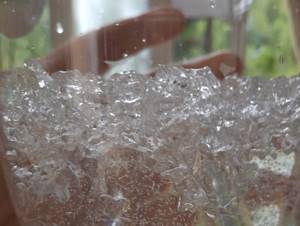
The question of using hydrogel, for example, in a garden bed, or whether it is safe for the environment when washing off its decay products with water is still open to me. © Anna Gower

